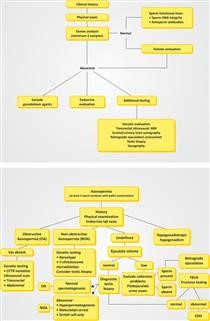The Infertility Website
Infertility at Age 42
You found your source for complete info and resources for Infertility at Age 42 online.
Transplantation of Rat Kidneys with Acute Tubular Necrosis into Salt-loaded and Normal Recipients. (PDF, 2 MB)Surgery, 1975. Primary infertility When a woman is unable to ever bear a child, either due to the inability to become pregnant or the inability to carry a pregnancy to a live birth she would be classified as having primary infertility. Patients may achieve normal virilization and adult phenotype by the administration of exogenous testosterone, but they are infertile. Electric or vibratory stimulation to achieve ejaculation: Ejaculation is achieved with electric or vibratory stimulation. Laparoscopy for Cryptorchidism. (PDF, 1 MB) The Journal of Urology, 1980. If a person is experiencing other symptoms, they may wish to speak to a doctor.
Hysterosalpingography: Fluid is injected into the woman's uterus and X-rays are taken to determine whether the fluid travels properly out of the uterus and into the fallopian tubes. Normal Pregnancies Resulting from Testicular Sperm Extraction and Intracytoplasmic Sperm Injection for Azoospermia Due to Maturation Arrest. (PDF, 6 MB) Fertility and Sterility, 1996. A varicocele is like a varicose vein that can appear in the leg.
Right here are Some More Resources on Average Infertility Treatment Cost

More Resources For Infertility at Age 42
It has been proven useful in overcoming infertility conditions, such as blocked or damaged tubes, endometriosis, repeated IUI failure, unexplained infertility, poor ovarian reserve, poor or even nil sperm count. Bushnik T, Cook JL, Yuzpe AA, Tough S, Collins J. Ovulation should be documented by serum progesterone level measurement at cycle day 21. The relation between daily activities and scrotal temperature.
Here are Some More Resources on Ultrasound for Infertility Diagnosis
Women in group II include those with polycystic ovary syndrome and hyperprolactinemia. For example, polycystic ovarian syndrome is when the eggs only partially developed within the ovary and there is an excess of male hormones.
Right here are Some Even more Resources on Ultrasound for Infertility Diagnosis
History-taking Couples with infertility problem should be interviewed separately as well as together, to bring out important facts that one partner might not wish to disclose to the other. The sperm is washed in a fluid and the best specimens are selected. If there is a history of recurrent miscarriages (2 or more) a lupus anticoagulant (LAC) and anti-cardiolipin antibody (ACL) are often done, as well as other tests. Sometimes there may be simple ways to make lifestyle adjustments to improve fertility, while other underlying causes may require treatment. If the urinary output remains low, albumin 25% (50 mL/h IV for 4 h) has been effective in promoting diuresis. Treatment of Female Infertility: Ovulation Induction Agents The main agents used for the induction of ovulation include: Clomiphene citrate is an orally active, nonsteroidal agent structurally similar to estrogen. Medical treatments[edit] Medical treatment of infertility generally involves the use of fertility medication, medical device, surgery, or a combination of the following. Other causes of ovulation disorders include ovarian insufficiency and hypothalamic amenorrhea. Surgical ablation: - In minimal or mild endometriosis; surgical ablation or resection of endometriosis plus laparoscopic adhesiolysis improves the chance of pregnancy. - Laparoscopic resection of endometriomas may be beneficial, however recent RCTs suggest intervention only in endometriomas > 4cm. - In moderate or sever endometriosis; surgical treatment should be offered. (Debatable) - Post-operative medical treatment does not improve pregnancy rates. Assisted conception The following methods are currently available for assisted conception. The most common identifiable causes of female fertility problems are outlined below: • Ovulatory dysfunction, (or anovulation) where an egg is not released from the ovary every month, is the single most common cause of female infertility. Affected individuals displayed more severe forms of infertility such as azoospermia and severe oligozoospermia.[27] Other causes[edit] Factors that can cause male as well as female infertility are: DNA damage DNA damage reduces fertility in female ovocytes, as caused by smoking,[28] other xenobiotic DNA damaging agents (such as radiation or chemotherapy)[29] or accumulation of the oxidative DNA damage 8-hydroxy-deoxyguanosine[30] DNA damage reduces fertility in male sperm, as caused by oxidative DNA damage,[31] smoking,[28] other xenobiotic DNA damaging agents (such as drugs or chemotherapy)[32] or other DNA damaging agents including reactive oxygen species, fever or high testicular temperature.[33] The damaged DNA related to infertility manifests itself by the increased susceptibility to denaturation inducible by heat or acid [34] or by the presence of double-strand breaks that can be detected by the TUNEL assay.[35] General factors Diabetes mellitus,[36][37] thyroid disorders,[38] undiagnosed and untreated coeliac disease,[39][40][41][42] adrenal disease[43] Hypothalamic-pituitary factors Hyperprolactinemia Hypopituitarism The presence of anti-thyroid antibodies is associated with an increased risk of unexplained subfertility with an odds ratio of 1.
Previous Next
See also
Unexplained Infertility Now What
Infertility Y Chromosome
Infertility Hospital in Nashik